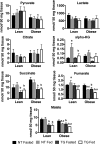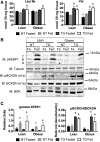Enhanced GLUT4-Dependent Glucose Transport Relieves Nutrient Stress in Obese Mice Through Changes in Lipid and Amino Acid Metabolism
- PMID: 27679559
- PMCID: PMC5127250
- DOI: 10.2337/db16-0709
Enhanced GLUT4-Dependent Glucose Transport Relieves Nutrient Stress in Obese Mice Through Changes in Lipid and Amino Acid Metabolism
Abstract
Impaired GLUT4-dependent glucose uptake is a contributing factor in the development of whole-body insulin resistance in obese patients and obese animal models. Previously, we demonstrated that transgenic mice engineered to express the human GLUT4 gene under the control of the human GLUT4 promoter (i.e., transgenic [TG] mice) are resistant to obesity-induced insulin resistance. A likely mechanism underlying increased insulin sensitivity is increased glucose uptake in skeletal muscle. The purpose of this study was to investigate the broader metabolic consequences of enhanced glucose uptake into muscle. We observed that the expression of several nuclear and mitochondrially encoded mitochondrial enzymes was decreased in TG mice but that mitochondrial number, size, and fatty acid respiration rates were unchanged. Interestingly, both pyruvate and glutamate respiration rates were decreased in TG mice. Metabolomics analyses of skeletal muscle samples revealed that increased GLUT4 transgene expression was associated with decreased levels of some tricarboxylic acid intermediates and amino acids, whereas the levels of several glucogenic amino acids were elevated. Furthermore, fasting acyl carnitines in obese TG mice were decreased, indicating that increased GLUT4-dependent glucose flux decreases nutrient stress by altering lipid and amino acid metabolism in skeletal muscle.
© 2016 by the American Diabetes Association.
Figures








Similar articles
-
Inhibition of carnitine palmitoyltransferase-1 activity alleviates insulin resistance in diet-induced obese mice.Diabetes. 2013 Mar;62(3):711-20. doi: 10.2337/db12-0259. Epub 2012 Nov 8. Diabetes. 2013. PMID: 23139350 Free PMC article.
-
Enhanced insulin action due to targeted GLUT4 overexpression exclusively in muscle.Diabetes. 1996 Jan;45(1):28-36. doi: 10.2337/diab.45.1.28. Diabetes. 1996. PMID: 8522056
-
Deletion of the Rab GAP Tbc1d1 modifies glucose, lipid, and energy homeostasis in mice.Am J Physiol Endocrinol Metab. 2015 Aug 1;309(3):E233-45. doi: 10.1152/ajpendo.00007.2015. Epub 2015 May 26. Am J Physiol Endocrinol Metab. 2015. PMID: 26015432 Free PMC article.
-
Metabolism and insulin signaling in common metabolic disorders and inherited insulin resistance.Dan Med J. 2014 Jul;61(7):B4890. Dan Med J. 2014. PMID: 25123125 Review.
-
Metabolic and molecular consequences of modifying GLUT4 expression in skeletal muscle.Biochem Soc Trans. 1997 Aug;25(3):963-8. doi: 10.1042/bst0250963. Biochem Soc Trans. 1997. PMID: 9388582 Review.
Cited by
-
Towards Understanding the Development of Breast Cancer: The Role of RhoJ in the Obesity Microenvironment.Cells. 2024 Jan 17;13(2):174. doi: 10.3390/cells13020174. Cells. 2024. PMID: 38247865 Free PMC article.
-
Mitigating sarcoplasmic reticulum stress limits disuse-induced muscle loss in hindlimb unloaded mice.NPJ Microgravity. 2022 Jul 11;8(1):24. doi: 10.1038/s41526-022-00211-w. NPJ Microgravity. 2022. PMID: 35817772 Free PMC article.
-
Transcriptomic analyses of Aedes aegypti cultured cells and ex vivo midguts in response to an excess or deficiency of heme: a quest for transcriptionally-regulated heme transporters.BMC Genomics. 2020 Aug 31;21(1):604. doi: 10.1186/s12864-020-06981-5. BMC Genomics. 2020. PMID: 32867680 Free PMC article.
-
Synergistic Anti-Angiogenic Effect of Combined VEGFR Kinase Inhibitors, Lenvatinib, and Regorafenib: A Therapeutic Potential for Breast Cancer.Int J Mol Sci. 2022 Apr 16;23(8):4408. doi: 10.3390/ijms23084408. Int J Mol Sci. 2022. PMID: 35457226 Free PMC article.
-
Sarcopenia in pulmonary diseases is associated with elevated sarcoplasmic reticulum stress and myonuclear disorganization.Histochem Cell Biol. 2022 Jan;157(1):93-105. doi: 10.1007/s00418-021-02043-3. Epub 2021 Oct 19. Histochem Cell Biol. 2022. PMID: 34665327
References
-
- Brüning JC, Michael MD, Winnay JN, et al. . A muscle-specific insulin receptor knockout exhibits features of the metabolic syndrome of NIDDM without altering glucose tolerance. Mol Cell 1998;2:559–569 - PubMed
MeSH terms
Substances
Grants and funding
LinkOut - more resources
Full Text Sources
Other Literature Sources
Medical
Molecular Biology Databases
Miscellaneous

